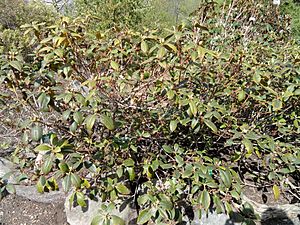Piedmont rhododendron facts for kids
Quick facts for kids Piedmont rhododendron |
|
|---|---|
 |
|
| Scientific classification | |
| Kingdom: | |
| (unranked): | |
| (unranked): | |
| (unranked): | |
| Order: | |
| Family: | |
| Subfamily: |
Ericoideae
|
| Genus: | |
| Subgenus: |
Rhododendron
|
| Section: |
Rhododendron
|
| Subsection: |
Carolinianum
|
| Species: |
R. minus
|
| Binomial name | |
| Rhododendron minus Michx.
|
|
| Synonyms | |
|
|
The Rhododendron minus, also known as the Piedmont rhododendron, is a beautiful flowering plant. It belongs to the rhododendron family. This plant is naturally found in the southeastern United States. You can spot it growing in states like Tennessee, North Carolina, South Carolina, Georgia, and Alabama.
This rhododendron species has two main types, called subspecies. These are Rhododendron minus var. chapmanii and Rhododendron minus var. minus. The second type is sometimes also called Rhododendron carolinianum.
Contents
Discovering the Piedmont Rhododendron
The Piedmont rhododendron is a type of shrub. It is known for its lovely flowers. These flowers often bloom in shades of pink or purple. Sometimes, they can even be white. The plant's leaves are usually dark green and shiny.
Where it Grows
This plant prefers specific places to grow. It often thrives in forests and along streams. You can find it in the Piedmont region. This area stretches across several states. It is known for its rolling hills and varied plant life.
Ideal Growing Conditions
The Piedmont rhododendron likes soil that is a bit acidic. It also needs good drainage. This means water should not sit around its roots. It can grow in both sunny and partly shady spots. However, it often does best with some protection from the hottest sun.
Plant Characteristics
The Rhododendron minus usually grows to be a medium-sized shrub. It can reach heights of about 6 to 10 feet (1.8 to 3 meters). Its flowers typically appear in late spring or early summer. They grow in clusters, making a beautiful display.
Leaves and Flowers
The leaves of this plant stay green all year. This makes it an evergreen shrub. The flowers have a unique shape. They often have small spots or flecks on their petals. These spots can be a different color than the main petal.
Reproduction and Life Cycle
Like many flowering plants, the Piedmont rhododendron reproduces using seeds. After the flowers bloom, they produce small seed capsules. These capsules contain tiny seeds. The seeds are then spread, often by wind or animals.
Growing from Seed
When the seeds land in a good spot, they can sprout. A new plant will begin to grow. It takes several years for a young rhododendron to mature. Once mature, it will start producing its own flowers and seeds. This completes its life cycle.
Importance of Rhododendrons
Rhododendrons are very popular plants. People often grow them in gardens. They add beauty to many landscapes. They are also important for their natural habitats.
Role in Ecosystems
In the wild, rhododendrons provide habitat for animals. They also help prevent soil erosion. Their flowers attract pollinators like bees. These insects help other plants reproduce too.
Conservation Efforts
Some types of rhododendrons face challenges. Their habitats might be shrinking. Protecting these plants is important. It helps keep our natural world healthy.

